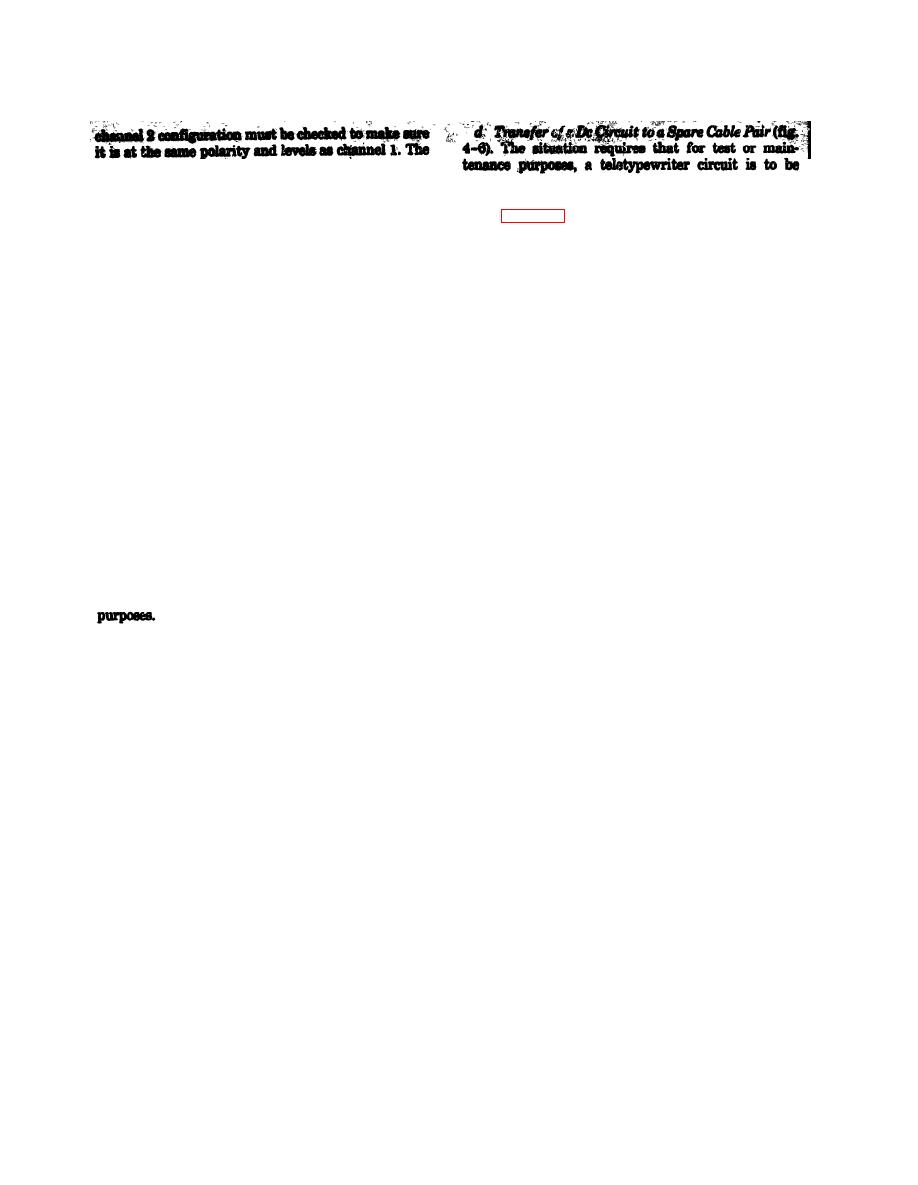 |
|||
|
|
|||
|
Page Title:
Section IV. FAILURES AND FAULT ISOLATION |
|
||
| ||||||||||
|
|
 TM 11-5895-1012-10
patching is accomplished at both the equal level dc and
transferred to the tail segment cable pair for spare
primary dc patch panels. Since the patch panels are
channel 2. This patch is made at the primary dc patch
normally physically separated, two Technical Con-
panel (fig. 2-15) and the Patch and Test Facility, or
trollers are needed to perform the operation with
similar patching facility, at the other end of the cable.
minimum interference to the user. The procedure
The patching operations are the same at both ends of
described below it the same at both patch panels.
the cable. Only the patching operation at the TCF is
(1) At the primary dc patch panel, place two patch
cord plugs loosely into channel 1 REC LINE and
covered below.
(1) Place two patch cord plugs loosely into the
TRANS LINE jacks. Place the plugs on the other end
channel 2 REC LINE and TRANS LINE jacks
of the patch cores loosely into channel 2 REC EQU and
(2) Place the plugs on the other end of the patch
TRANS EQU jacks respectively.
cords loosely into the channel 1 REC EQU and TRANS
(2) At the equal level dc patch panel place the
EQU jacks respectively.
patch cord plugs loosely into the channel 1 REC LINE and
(3) Establish voice contact between the TCF and
TRANS LINE jacks. Place the plugs on the other end
of the cords loosely into channel 2 REC EQU and
PTF.
(4) The Technical Controller will take charge, and
TRANS EQU jacks respectively.
on a prearranged signal, usually the count-of-three, all
(3) Establish voice contact between the two patch
loose plugs are set into the jacks simultaneously.
panels. On the count-of-three, all loose plugs are set
into the jacks simultaneously.
Section IV. FAILURES AND FAULT ISOLATION
4-22. General
All service interruptions must be logged, regardless of
period of outage.
a. All transmission media with breakout capability
entering a DCS Station appears on the jack fields in
4-24. fault Isolation
the Technical Control Facility for control and restoral
Fault isolation is the process of determining the loca-
tion of a trouble within a circuit, or within the trans-
b. The Technical Controllers are responsible for all
mission media which carries the circuit The trouble
transmission media entering, terminating or transit-
could be in any of the transmitting facilities of one sta-
ing a DCS Station.
tion, the receiving facilities of the adjacent station, the
(1) All traffic will be stopped where practicable
media connecting them, or the user's equipment which
before any action is taken that will interrupt its flow.
terminates the circuit. After the general area of a
When actions can be predicted; e.g. scheduled main-
trouble has been isolated; e.g. media, user equipment,
tenance, the user will be notified in advance in order
access lines, etc., a decision can be made to provide the
that traffic may be stopped at the scheduled time.
quickest method of restoral. Fault isolation is not a
(2) Occasionally, traffic will be interrupted due
finger-pointing or blame-fixing exercise. The basic
to unforeseen events, such as transmission media
purpose is to locate the source of a trouble and get it
degradation or equipment failure, Traffic may also be
fixed, regardless of where it is, or which piece of equip
interrupted by preemption of the circuit to restore a
ment is at fault. The same problem recurring at fre-
higher priority user. In all such cases, the user will be
quent intervals is of prime concern to both DCA and
notified of the transmission media failure or preemp-
the operation and maintenance agency, and corrective
tion to permit them to stop traffic and maintain con-
measures must be taken. However, this is a by-
tinuity.
product, not the purpose of fault isolation.
4-23. Circuit Outages
a. The first step in fault isolation is the recognition
The Technical Controller is responsible for identifica-
that a problem exists. On the surface, fault recognition
tion of all outages or interruptions on the circuit. Tech-
may seem to be a trite statement. However, the major-
nical Controllers are also responsible for restoration of
ity of problems are the result of someone failing to
service with minimum loss of operating time. Con-
recognize that trouble signs are appearing. Trouble
trollers will test, monitor, and observe outgoing and
recognition may be a result of quality control testing,
incoming circuits and channels to ensure proper opera-
equipment sensors and alarms, customer complaint, or
tion. They will coordinate with distant stations and
any combination of these. The main point is that when
local users, as necessary to isolate the report troubles.
the trouble signs appear, regardless of how or from
|
|
Privacy Statement - Press Release - Copyright Information. - Contact Us |